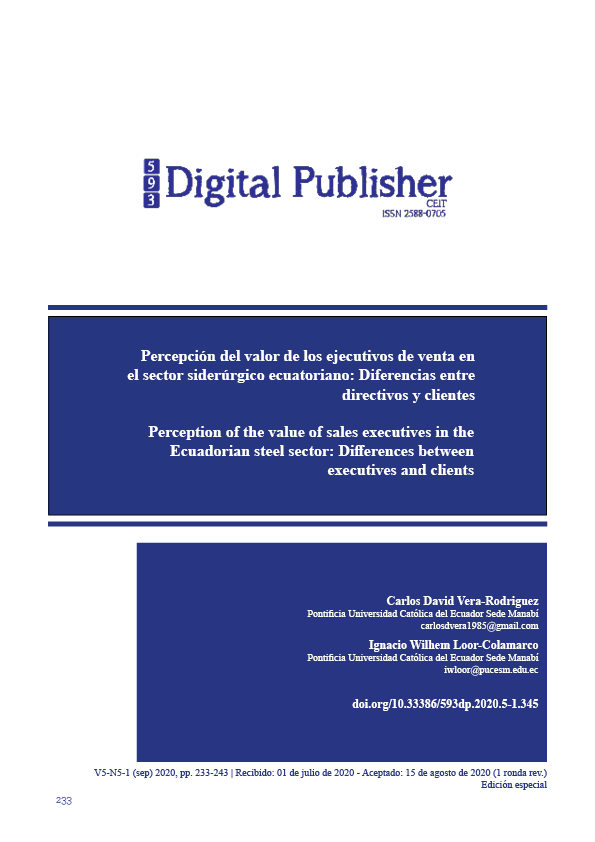Perception of the value of sales executives in the Ecuadorian steel sector: Differences between executives and clients
Main Article Content
Abstract
The paper investigates how, in the Ecuadorian siderurgical industry, the perceived value of the sales force diverges between the upper management levels and their corporate customers. An adaptation to the Hay Group model of competence assessment is used in this research, in which the upper managers and corporate customers played the role of assessors. The study identifies a gap in the perceived value. The customers perceive a higher value than upper managers.
Downloads
Article Details
1. Derechos de autor
Las obras que se publican en 593 Digital Publisher CEIT están sujetas a los siguientes términos:
1.1. 593 Digital Publisher CEIT, conserva los derechos patrimoniales (copyright) de las obras publicadas, favorece y permite la reutilización de las mismas bajo la licencia Licencia Creative Commons 4.0 de Reconocimiento-NoComercial-CompartirIgual 4.0, por lo cual se pueden copiar, usar, difundir, transmitir y exponer públicamente, siempre que:
1.1.a. Se cite la autoría y fuente original de su publicación (revista, editorial, URL).
1.1.b. No se usen para fines comerciales u onerosos.
1.1.c. Se mencione la existencia y especificaciones de esta licencia de uso.
References
Arslanagic-Kalajdzic, M., & Zabkar, V. (2015). The external effect of marketing accountability in business relationships: Exploring the role of customer perceived value. Industrial marketing management, 46, 83-97. https://doi.org/10.1016/j.indmarman.2015.03.002
Arslanagic-Kalajdzic, M., & Zabkar, V. (2017). Is perceived value more than value for money in professional business services? Industrial Marketing Management, 65, 47-58. https://doi.org/10.1016/j.indmarman.2017.05.005
Attia, A. M., Honeycutt Jr, E. D., & Attia, M. M. (2002). The difficulties of evaluating sales training. Industrial Marketing Management, 31(3), 253-259. https://doi.org/10.1016/S0019-8501(00)00133-4
Aurum, A., & Wohlin, C. (2007, June). A value-based approach in requirements engineering: explaining some of the fundamental concepts. In International Working Conference on Requirements Engineering: Foundation for Software Quality (pp. 109-115). Springer, Berlin, Heidelberg. https://doi.org/10.1007/978-3-540-73031-6_8
Bui, H. Q. T., & Nguyen, T. H. (2012). Resources for service quality improvement as competitive advantages: A conceptual model for services firms in Vietnam. Journal of Sustainable Development, 5(9), 141. https://doi.org/10.5539/jsd.v5n9p141
Foss, N. J., Klein, P. G., Lien, L. B., Zellweger, T., & Zenger, T. (2020). Ownership competence. Strategic Management Journal. https://doi.org/10.1002/smj.3222
Heinonen, K. (2004). Time and location as customer perceived value drivers. Svenska handelshögskolan. http://urn.fi/URN:ISBN:951-555-818-2
J. Azar, R.K. Smith, and D. Cordes, “Value-oriented requirements prioritization in a small development organization,” IEEE Software, vol. 24, 2007, pp. 32-37. https://doi.org/10.1109/MS.2007.30
Lizola-Romero, R., Bedolla-García, S., Conde-Escudero, A., Gaxiola-Loc, F. J., & Sánchez-Vázquez, M. A. (2018). Modelo de negocio para el desarrollo de habilidades suaves en los colaboradores. Recuperado de: https://rei.iteso.mx/bitstream/handle/11117/5539/Modelo+de+negocio+para+el+desarrollo+de+habilidades+suaves+en+los+colaboradores.pdf?sequence=2
Pettijohn, C., Pettijohn, L. S., Taylor, A. J., & Keillor, B. D. (2001). Are performance appraisals a bureaucratic exercise or can they be used to enhance sales‐force satisfaction and commitment? Psychology & Marketing, 18(4), 337-364. https://doi.org/10.1002/mar.1011
Prior, D. D. (2013). Supplier representative activities and customer perceived value in complex industrial solutions. Industrial Marketing Management, 42(8), 1192-1201. https://doi.org/10.1016/j.indmarman.2013.03.015
Santana-Robles, F. (2020). La evaluación por competencias. Ingenio y Conciencia Boletín Científico de la Escuela Superior Ciudad Sahagún, 7(13), 69-70. https://doi.org/10.29057/escs.v7i13.5154
Sharma, D., Aurum, A., & Paech, B. (2008, September). Business value through product line engineering-a case study. In 2008 34th Euromicro Conference Software Engineering and Advanced Applications (pp. 167-174). IEEE. https://doi.org/10.1109/SEAA.2008.19
(2000). The American Heritage dictionary of the English language. Boston: Houghton Mifflin, https://ahdictionary.com/



